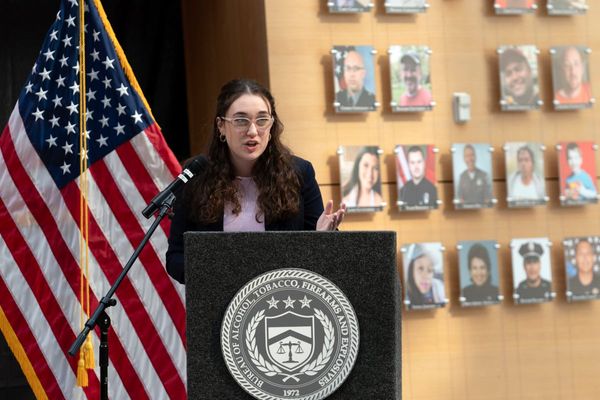
London fashion week is always an exciting and vibrant time for the UK capital but this year, as far-right protesters sweep the streets, it felt more significant than ever as a visual counter against those images. And naturally, Black designers led the way in offering alternative visions of Britain..
I was lucky enough to attend the spring/summer 2026 show by Labrum, the label of British-Sierra Leonean designer Foday Dumbuya, which was titled Osmosis. As Dumbuya writes in an essay expanding on the show: “Cultural osmosis represents the profound exchange of cultural elements that occurs when diverse communities interact and inspire one another.”
The show was at Central Hall Westminster, and on my way in I couldn’t help but reflect on the scenes that took place here just a week prior, when more than 100,000 people mobilised under the direction of the far-right activist Tommy Robinson, spouting hate speech, racist conspiracy theories and anti-migrant rhetoric. I live a few stops away on the London underground, so I had compelled myself to witness the protests, their numbers and their narrative – which left me questioning what hope there can be for those of us who by birth, journey or heritage are still considered “other”.
But culture is often the best antidote in these times. Fashion in particular can be a powerful tonic against the rising tide of hate. And in the hall in Westminster, Dumbuya built a capsule that investigated and praised freedom of movement: how Black diasporic cultures come together and interact with their new homes, bringing tradition with them, and creating something wonderful. The show opened with an orchestra featuring strings and brass instruments alongside west African talking drums and djembes and digital riddims – a blend of classical, traditional and futuristic sounds that created a hybrid and spectacular soundscape speaking to those interactions between lands.
The poet and spoken word artist Julianknxx performed a piece indicative of the show’s ethos, asking: “What song are we going to sing for the migrants that built this country / I’m listening / for the next song / that remembers our parents / shaking the sweat of a bird when / the going gets tough.” Dumbuya’s collection felt like a response to that question, in how the clothes themselves honoured heritage and history.
In the show, British tailoring and suiting were the canvases for west African textiles, illustrative of the movement between these lands: a meeting of formality and elegance with an explosion of rich tones and colours created through dyes and patterns. Watching the runway models pass by in the most elaborate designs, I was struck by the repeated motif of cowrie shells – a small shell produced by sea snails which have had lasting economic and cultural significance across African nations – threaded into the headgear and suiting of the collection. That alone resonated as a kind of symbol of cross-African unity.
Even more powerful were the military silhouettes and the shako and other military style headgear of marching bands, some stacked on top of each other creating a pagoda effect, to riff on the ceremonial head adornment Ekonda Botolo worn in the Democratic Republic of Congo. With the crises afflicting DRC, the Rwandan-backed paramilitary group M23 killing civilians amid a fight over mineral wealth, the image created reminded me of the casualties of these wars and conflicts. But it also served as a reflection of those who had been called to service – whether by their own governments to fight civil or inter-African wars, or by the British and French empires in both world wars.
While beautiful and intricate, these visual cues were not only about communicating a sense of grace and refinement, they were also imbued with political messaging. With war and conflict comes displacement, and with that comes refugees who only want to find relief in new homes. The Labrum show celebrates the stunning cultural symbiosis that has been a by-product of movements like this.
Elsewhere, the Jamaican-born Cayman Island-raised designer Jawara Alleyne presented his collection titled Tabanca, a Caribbean word that describes a kind of lovesickness and, in this instance, as he explained to the London Standard, “the feeling that you get after carnival has ended” – reminiscent of Bunji Garlin’s 2014 hit song Carnival Tabanca. Viewing images of the collection, you can see how it is a celebration of carnival’s creativity: the colourful, draped and shredded fabrics, and the riffs on traditional masquerade characters. Meanwhile, Tolu Coker’s collection, Unfinished Business, was presented as a film celebrating Black women’s lives and legacies and the idea of women passing heirlooms and stories down to one another.
These collections all speak to the power of cross-cultural exchange, inheritance and dialogue at a time of increasing division. And thus Black designers are architects of culture and storytellers – using their work to examine the experiences and lands that have shaped them and their place in Britain. From the catwalk to the closet, garments and their history can be a very physical reminder of how much there is to fight for when critics of multicultural life want only absolute conformity or exile.
• To receive the complete version of The Long Wave in your inbox every Wednesday, please subscribe here.







